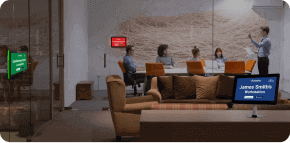Blog

Making Flex-seating work: How to succeed with hoteling and office scheduling tools.
The current work from home imperative has amply demonstrated that it (working remotely) is practical. However, the 2.5-percent decline in nonfarm business sector labor productivity in Q1 of 2024, reflected the most significant quarterly decline since Q4 of 2015. While a large part of that decrease may have come from lost hours worked, some of it may also have to do with work-from-home inefficiencies.
Both employees and employers may therefore be thinking about flexible options to work from home and from the office, should they choose to; and office space management software is the way to plan and implement such strategies.
Why flex your workspace muscles?
The world of flexible workspace isn’t new at all! In fact, many global corporations offer it as an option to employees supporting geographically dispersed teams, across multiple time zones. The idea behind flex work is that staff work an agreed number of hours per week, but there’s ample flexibility in when and where they work. So, why would organizations allow for such work schedules?
1) Firstly, as noted earlier, operational requirements sometimes require flexibility
2) Secondly, some employees work best in certain situations, like from their cottage homes or between 6.00 PM and 4.00 AM – they may be “night people”!
3) Finally, some talented individuals might have other commitments – like caring for elderly parents or young children – which precludes them from working “regular” hours. Flex work is one way to retain such talent within the organization
So, while flex work keeps employees and employers happy, it does impact workspace allocation and scheduling. For instance, why would a company assign a permanent office to an executive who will not be working at the office for the next 7 months? Or, why “reserve” a desk for 24-hours a day. When a staff member only uses it from 6.00 PM to 4.00 AM? Why not let someone else make use of that asset during “regular” working hours?
The workspace jugglers’ companion
Flexi-work isn’t just a cliché – it’s a smart way to optimize and use scarce workspaces in today’s new workplace paradigm. However, planning, implementing and monitoring flexi-work schedules is a juggling act. Because individuals and groups of employees might constantly have revolving plans for being at the office (or away!). It’s hard for pen and note book scheduling to keep up. And no matter how intelligent your macro-driven Excel spreadsheet is. It’ll always end up overbooking, double booking and not booking workspace resources.
Flex office software is the right tool for the challenge. With DeskFlex Room Booking software, workspace administrators can efficiently schedule office space, conference rooms, and office equipment without worrying about messing things up. In fact, because these tools are integrated with the corporate scheduling tools and staff directories, like Microsoft Exchange. And Active Directory, staff have the power to view available desks, cubicles and rooms, book them or release them online. And even cancel and rebook if their plans change in an instant.
When coupled with other workspace Facility and Room Scheduling tools, people managers and workspace administrators can use space management software to make flex work extremely productive. Not only will staff have a stress-free working day (week, month!). But it’ll also optimize the use of scarce and expensive workspace across the organization.




















































 Support
Support  Demo
Demo  Blog
Blog